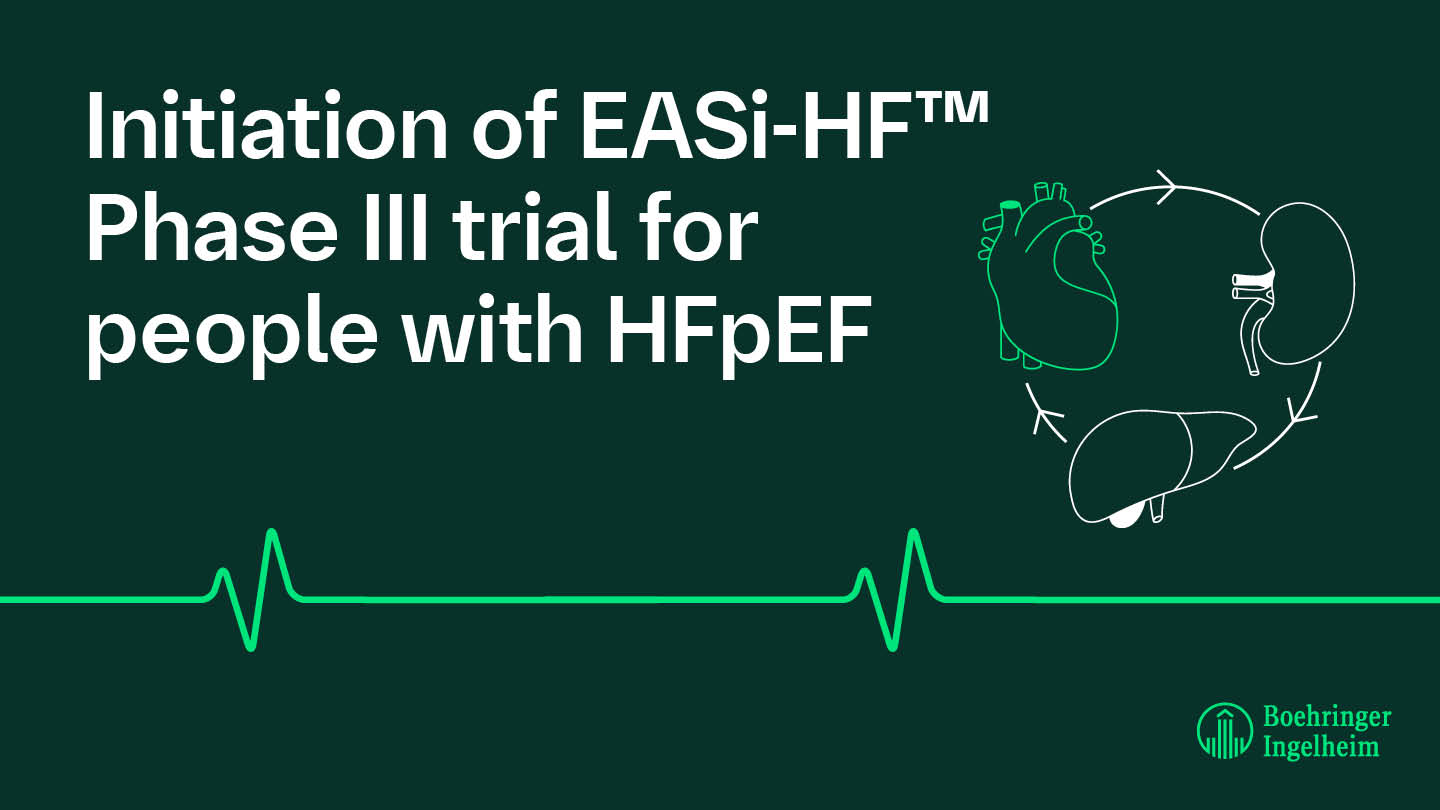Breaking barriers in heart failure care and interconnected cardiovascular, renal and metabolic conditions
Do you ever stop to think about what it means when describing someone as having a heart of gold, or advising others to follow their heart? If you’re one of the 60 million people worldwide living with chronic heart failure, then following your heart isn’t as easy as it sounds. Sandy Sommer, Head of the Therapeutic Area for Cardiovascular, Renal and Metabolic at Boehringer Ingelheim, delves into why the initiation of the EASi-HF™ Phase III clinical trial holds such significance for patients worldwide.

The stark reality of chronic heart failure and need for early intervention
One in five people are at risk of developing heart failure in their lifetime. As a long-term condition where the heart doesn’t pump blood as effectively as it should to supply enough oxygen-rich blood around the body, it’s no secret that the heart failure prognosis is stark. We know that currently over half of people diagnosed with heart failure will die within five years of diagnosis. Managing heart failure symptoms such as shortness of breath, fatigue, and fluid retention can enhance quality of life. Yet, the urgent need for advancements in early detection and the development of more effective treatments remains. People living with chronic heart failure often require frequent hospitalization, posing a heavy burden both on the individuals affected and on healthcare systems.
"People at risk for heart failure need to be identified and diagnosed early, so that treatment can be initiated as soon as possible. Early heart failure intervention can lead to significant improvements in long-term outcomes for patients.” – Dr Waheed Jamal, M.D., Corporate Vice President and Head of Cardiovascular Renal Metabolic Medicine at Boehringer Ingelheim
The interconnectedness of cardiovascular, renal and metabolic conditions
Heart failure should not be treated in isolation; it is closely connected with other cardiovascular, renal and metabolic conditions, including chronic kidney disease, type 2 diabetes, obesity and hypertension, all of which can amplify risks. Dysfunction in one system can contribute to dysfunction in others, and around half of people living with heart failure also have chronic kidney disease.
We must also connect for improved care across the cardiovascular, renal and metabolic spectrum by forging powerful partnerships with healthcare systems, governments, payers, academic institutions, patient organizations, and digital health providers. By working together, we can champion the urgent need for evidence-based solutions with transformative potential.
“Cardiovascular, renal and metabolic conditions can develop in sync, like chronic kidney disease, type 2 diabetes and heart failure. Many people who visit their doctor with one disease are likely to have another one without knowing it, or it’s only a matter of time before others develop. These diseases do not run independently and have an incremental impact on prognosis. If you have two diagnoses, then unfortunately one plus one turns out to be more than two when it comes to the toll on the body.
The real hope for people living with these conditions is having an effective therapy that can improve outcomes in multiple diseases across the cardiovascular, renal and metabolic system simultaneously.” – Dr Javed Butler, M.D., M.P.H., M.B.A., President, Baylor Scott and White Research Institute, DallasTX and Professor of Medicine, University of Mississippi, Jackson MS
The potential of combined therapy treatments for improved heart failure care
The initiation of our EASi-HF™ Phase III trial marks a major step in our pursuit of a potential treatment for people living with chronic heart failure with preserved ejection fraction (HFpEF). HFpEF happens when heart muscles contract normally but the left ventricle does not fill with enough blood, often due to stiffening of the heart muscle. EASi-HF™ is the first clinical trial testing a novel selective aldosterone synthase inhibitor (ASi), vicadrostat, previously known as BI 690517, in people with heart failure and whose hearts can pump at least 40% of its blood volume. We’re currently investigating the efficacy and safety profile of vicadrostat given in combination with empagliflozin, compared to placebo and empagliflozin on top of standard of care. This will provide valuable insights into whether the potential treatment can reduce the risk of cardiovascular death or hospitalization due to heart failure. Vicadrostat is an investigational drug, which has not been approved for any proposed indication by any regulatory authority including the U.S. Food and Drug Administration. Boehringer Ingelheim is currently investigating its efficacy and safety profile.
So, how is this combination therapy intended to work? Vicadrostat has a novel mode of action that inhibits the production of aldosterone. Elevated aldosterone levels can cause organ damage and may make cardiovascular, renal and metabolic related conditions worse, including chronic heart failure and chronic kidney disease. Lowering excess aldosterone levels has the potential to significantly improve the disease trajectory for patients, and the combined use of vicadrostat with empagliflozin showed promising results in a Phase II trial in chronic kidney disease in 2023. Empagliflozin may mitigate the risk of hyperkalemia (elevated potassium levels) that can occur as a result of aldosterone synthase inhibition. There are currently no approved treatments for HFpEF that lower aldosterone levels effectively, highlighting the significant potential of our EASi-HF™ Phase III trial.
“We know serum aldosterone levels correlate with poor prognosis in patients. ASi may hold the promise for incremental benefit by reducing aldosterone levels. In addition, the risk of hyperkalemia may be mitigated in combination with an SGLT2 inhibitor like empagliflozin.” – Dr Javed Butler
Cardiovascular, renal and metabolic conditions pose one of the fastest-growing health challenges of our time. Patients need new treatment options with a preferable benefit-risk profile, and that are easy to use. There is potential for vicadrostat with empagliflozin to improve overall cardiovascular, renal and metabolic health, as positive outcomes in one condition may translate into benefits in others.
“The cardiovascular, renal and metabolic clinical paradigm needs to shift away from treatment of individual conditions. Improved communication and collaboration are needed among healthcare professionals to tackle interconnected cardiovascular, renal and metabolic conditions so that we treat the whole body more effectively.” Dr Waheed Jamal
We have a heart full of determination to drive innovative, integrated and long-term sustainable treatment solutions that positively impact the lives of people living with chronic heart failure and other interconnected cardiovascular, renal and metabolic diseases. Through active partnerships, our cutting-edge research, and the development of new, evidence-based treatments, we strive to restore balance within the cardiovascular, renal and metabolic system and connect for care to transform lives for generations.
Related Press Releases

Boehringer Ingelheim achieves major milestone in chronic kidney disease
Related Content

Positioning in Cardiovascular, Renal and Metabolic Diseases


